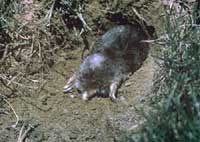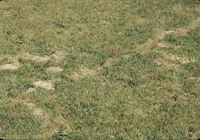| |

Call
now
to solve your Mole problems.
727-710-0373
Click
here for a free estimate
Moles
The Eastern Mole is common throughout
the Tampa Bay area.
Moles are very beneficial to the
environment because they eat mole
crickets and other harmful bugs
and insects.
Unfortunately
while looking for food moles will
leave unsightly tunnels that show
above they surface of your landscape. We specialize in Tampa mole control.
Call
today to have your mole problem
resolved!
727-710-0373
|
Excerpt
from article:
Moles
William H. Kern, Jr.
Description
The eastern mole, Scalopus aquaticus,
occurs throughout Florida. Moles are
not rodents but belong to the mammalian
Order Insectivora. Insectivora means
insect eater, and this group includes
moles, shrews, and hedgehogs. The most
notable aspect of the mole is its large,
powerful front feet, designed for pushing
soil out of its way (Figure 1). The
eastern mole has an average total length
of 5½-6in (14-15cm) and a short, sparsely
haired tail 1-1½in (2.5-3.8cm) long.
The fur is very soft and differs from
that of most mammals because it does
not project toward the tail. With their
fur pointing up, moles can move forward
or backward within their tunnels without
rubbing their fur the wrong way and
trapping soil in their coats. The coat
is so fine and dense that it keeps out
water and dirt. The fur is slate gray
with a velvety sheen. Moles living in
red clay soils sometimes appear rusty
in color. Their bellies may be slightly
lighter in color, and some individuals
may have tan or orange blotches on their
bellies.
The star-nosed mole, Condylura cristata,
has been collected in the Okefenokee
Swamp in Georgia and has been reported
in Florida. It is identified by numerous
fleshy, fingerlike projections around
the tip of its nose. This mole is normally
found in wet soils, in marshes, and
along streams, so it rarely causes problems
in yards and turf. Because of its rarity
in Florida, the star-nosed mole will
not be discussed further.
Habitat and
Food
The eastern mole prefers loose, well-drained
soils. It has been found in dune sand
and rich forest humus. The characteristic
mole ridges that lie just below the
surface are foraging tunnels . These
tunnels are created as the mole searches
among the plant roots for the earthworms
and insects on which it feeds. Moles
are beneficial because they eat mole
crickets; beetle larvae (white grubs,
wire worms, etc.); ants and ant brood;
moth larvae and pupae (cutworms and
armyworms); and slugs. They also help
to loosen and aerate the soil. In loose
soil, moles can tunnel up to 18ft (5.4m)
per hour. Their living space is in tunnels
and chambers 6-12in (15-30cm) below
the surface. Soil from these deep burrows
is pushed to the surface in small mounds.
Reproduction
The mole's nest chamber is 4-6in (10-15cm)
in diameter and lined with fine grass
and leaves. Moles have one litter of
2-5 young per year. The young are born
in March after a 45-day gestation period.
They are large at birth relative to
the size of their mother and are able
to fend for themselves in about four
weeks.
Damage and Control
The damage caused by moles is almost
entirely cosmetic. Although moles are
often falsely accused of eating the
roots of grass and other plants, they
actually feed on the insects causing
the damage. The tunneling of moles may
cause some physical damage to the root
systems of ornamental or garden plants
and may kill grass by drying out the
roots, but this damage is usually minor.
When mole tunnels become
an intolerable nuisance, moles may be
captured and removed without a permit
by homeowners, renters, or employees
of the property owner. If a lawn service
or pest control technician is hired
to trap nuisance animals, that person
must have a Nuisance Wildlife Permit
or registration issued by the Florida
Fish and Wildlife Conservation Commission
(FWC). No poison (bait or fumigant)
may be used on native wildlife without
a Poison Permit issued by the executive
director of the FWC. Because suitable
traps are available for mole control,
it is extremely difficult to justify
the use of poisons and the Commission
has decided not to issue any Poison
Permits for moles in Florida. This effectively
makes the use of any mole poison illegal
in Florida. As of summer 2007, the Florida
Department of Agriculture and Consumer
Services is considering suspending registration
of all mole poisons in Florida to conform
with the state's wildlife regulations.
Flooding the tunnels
with water may force moles to the surface,
but this method rarely works in deep,
sandy soils like those common in Florida.
Small, sensitive areas
can be fenced to keep out moles, gophers,
and pine voles (Figure 4). The barrier
should be made with small-mesh galvanized
hardware cloth, brick, or concrete.
The barrier should extend at least 6in
(15cm) above the ground and 2ft (0.6m)
below the ground, with an outward projection
extending 3-6in (7.6-15cm).
Moles can be discouraged from digging
foraging tunnels in turf by controlling
the populations of insects on which
they feed. Elimination of white grubs,
mole crickets, and other soil insects
will make an area less attractive to
moles. Identify the insect pests so
the appropriate control method can be
used. Ask your local county horticultural
extension agent to recommend insecticides
for your particular insect problem.
Always follow label directions when
using any pesticide. Nematodes or bacteria
that parasitize insects can be used
instead of chemical pesticides to control
turf insects. If your soil is rich in
organic material and supports a large
earthworm population, insecticide treatments
will not necessarily discourage moles.
Also, be aware that insecticide treatment
of an area may cause moles to tunnel
more to seek out a diminishing food
supply.
Several mole repellents
are available that use emulsified castor
oil to repel moles from treated areas.
The duration of effectiveness of these
products is related to soil type and
the amount of rainfall. They remain
effective longer in clay and loam soils
than in sandy soils. During rainy periods,
these products may need to be applied
more often. Always read and follow label
instructions.
The use of vibrating
devices to drive away moles has not
been proven effective in scientific
trials. In fact, the presence of mole
tunnels next to highways would seem
to be evidence against the effectiveness
of these devices. The same is true for
the use of mothballs to repel moles.
The mole just blocks off the treatedtunnels
and moves to a different part of the
yard. Many people claim that putting
sticks of Wrigley's Juicy Fruit gum
into moles' tunnels will eliminate the
moles. This is another method not proven
in scientific tests.
References
Hamilton, Jr., William J. and John O.
Whitaker, Jr. 1979. Mammals of the Eastern
United States. Cornell Univ. Press,
Ithaca, NY.
Lowery, Jr., George
H. 1974. The Mammals of Louisiana and
its adjacent waters. Louisiana State
Univ. Press, Baton Rouge, LA.
Olkowski, Helga. 1988.
Much ado about moles. Common Sense Pest
Control 4(2): 4-8.
Footnotes
1.
This document is WEC-66 (UW080), one
of a series of the Department of Wildlife
Ecology and Conservation, Florida Cooperative
Extension Service, Institute of Food
and Agricultural Sciences, University
of Florida. Publication: May 1994. Revised:
August 2007. Please visit the EDIS Web
site at http://edis.ifas.ufl.edu.
2.
William H. Kern, Jr., associate professor,
Entomology and Nematology Department,
Ft. Lauderdale, Research and Education
Center, Davie, FL 33314, and the Cooperative
Extension Service, Institute of Food
and Agricultural Sciences, University
of Florida, Gainesville, 32611.
--------------------------------------------------------------------------------
The Institute of Food
and Agricultural Sciences (IFAS) is
an Equal Opportunity Institution authorized
to provide research, educational information
and other services only to individuals
and institutions that function with
non-discrimination with respect to race,
creed, color, religion, age, disability,
sex, sexual orientation, marital status,
national origin, political opinions
or affiliations. For more information
on obtaining other extension publications,
contact your county Cooperative Extension
service.
U.S. Department of Agriculture,
Cooperative Extension Service, University
of Florida, IFAS, Florida A. & M.
University Cooperative Extension Program,
and Boards of County Commissioners Cooperating.
Millie Ferrer, Interim Dean. |
|
|

Licensed and insured nuisance wildlife
trapper. Let me help
you with your Mole
control.
|
| 
The
Trapper Guy is not a pest control
company. I do not
use poisons or service bugs.
|
 |
|